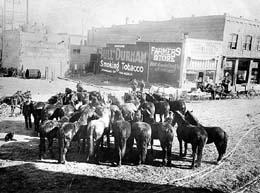On September 16, 1902, the town of Sunnyside votes in favor of incorporation. The vote is 42 to one. Druggist James Henderson becomes the town’s first mayor.
Water engineer Walter Granger founded Sunnyside in 1893. Granger, under the auspices of Northern Pacific Railroad president Thomas F. Oakes, was responsible for the construction of the Sunnyside Canal. This canal brought Yakima River water to the north slope of the Yakima Valley. The town of Sunnyside, a cheerful moniker bequeathed by early merchant W. H. Cline, was platted by Granger next to this canal.
The town was heavily promoted as a Garden of Eden in the making. The national financial Panic of 1893, however, forced the Northern Pacific Railroad into receivership and Granger’s Sunnyside Canal Company into the control of his creditors. Sunnyside’s population dwindled down to seven families.
In 1898, members of the German Baptist Progressive Brethren chose Sunnyside for the location of their newly formed Christian Cooperative Colony. The Progressive Brethren, also known as “Dunkards,” presumably baptized their flock in the canal or perhaps in the Yakima River. The Brethren bought the town site development company and included a morality clause (no drinking, dancing, gambling, or horseracing) in every land deed they sold. So completely associated was Sunnyside with the Christian Cooperative Colony that some older maps of Washington use a cross or a halo icon to identify the location of the town.
The Christian Cooperative Colony built and owned the bank and telephone system.
At the time Sunnyside voted to incorporate there was some doubt as to whether the town was large enough to hold such a vote. Washington law required that a town have at least 300 citizens in order to vote incorporation. A census of Sunnyside found 314 citizens, and so the vote was on.
The town quickly swelled with immigrants from South Dakota, a “Dunkard” stronghold, and in the 1930s gained refugees from the drought that devastated many Midwestern states. These families quickly learned the mechanics of irrigated farming. Water was plentiful thanks to the canal system, the volcanic soil was arable and rich, and the railroad always ready to transport the farmers’ produce to markets near and far away.

